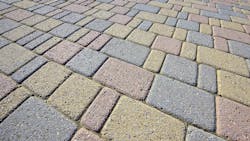The pore-like structure of permeable pavements may help protect coho salmon by preventing tire wear particles and related contaminants from entering stormwater runoff, according to a press release from Washington State University.
Researchers demonstrated that four types of permeable pavements can act as giant filters, retaining more than 96% of applied tire particle mass. They also captured several tire-associated chemicals, resulting in a 68% average reduction of 6PPD-quinone, a contaminant shown to kill coho salmon in urban streams. The study findings were published in the journal Science of the Total Environment.
“The pressure on existing stormwater management technologies is becoming problematic, especially with climate change and increased development,” said lead author Chelsea Mitchell. “Permeable pavements are a very promising type of green stormwater infrastructure because they could treat this type of pollution where it’s generated, rather than downstream.”
In 2020, scientists at the Washington Stormwater Center discovered that 6PPD, a chemical found in tires, transforms into 6PPD-quinone when exposed to ozone or sunlight. Even in small concentrations, 6PPD-quinone is deadly to salmon.
For the latest study, researchers, worked in an active parking lot at the School of Industrial Design, Engineering and Art in Tacoma, Washington, running a series of tests on four permeable pavements made of either asphalt or concrete. The pavements were created in collaboration with Boeing, which provided research funding, as well as Tacoma Public Schools and the City of Tacoma.
First, the researchers mimicked a rain event by flushing water through the pavements, measuring the background level of existing pollutants. The next day, they deposited ground-up used tire tread across a dosing area. They again simulated a rainstorm, measuring how much of the deposited particles and associated chemicals were retained.
A third water flushing experiment helped the researchers measure the likelihood that 6PPD-quinone and other chemicals would continue leaching off retained tire particles during future rainstorms.
“Permeable pavements make a difference in managing 6PPD-quinone and its source — tire wear particles,” said study co-author Jayakaran. “6PPD-quinone is hydrophobic, and we think the chemical is being absorbed into the internal surfaces of the pavement system.”
Because of their void spaces, permeable pavements are inherently weaker than their traditional counterparts, making it hard for them to withstand heavy traffic flows.
Researchers in the WSU Voiland College of Engineering and Architecture previously demonstrated that using carbon fiber composite scraps derived from Boeing airplane wings could make the pavements stronger.
The new research could have a vast impact, the authors said. Salmon are significant to Native nations’ culture and to upholding their treaty rights to harvest salmon from streams. The technology could also have human health implications.
“Tire particles are so fine they can become airborne and possibly enter the human body through even a gentle breeze. And even in small doses, 6PPD-quinone is toxic to salmon,” Jayakaran said. “Both could impact human health, especially in communities who live near busy roads.”
Though the study findings are encouraging, Mitchell and Jayakaran emphasize that more testing is necessary, and widespread use of the novel infrastructure presents some challenges. Permeable pavements are sometimes installed in a new subdivision or a road undergoing repair, but the cost of replacing existing roads and parking lots is high.






